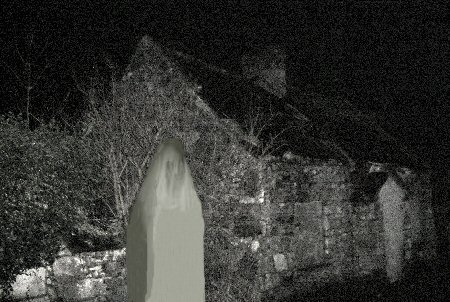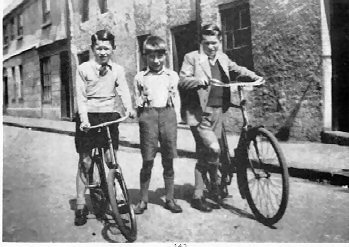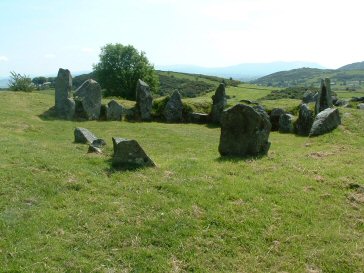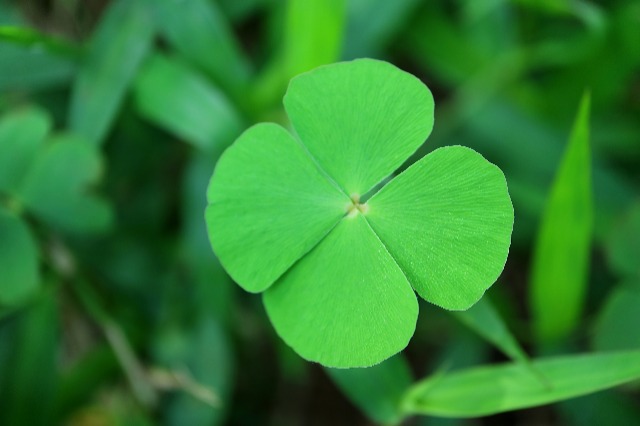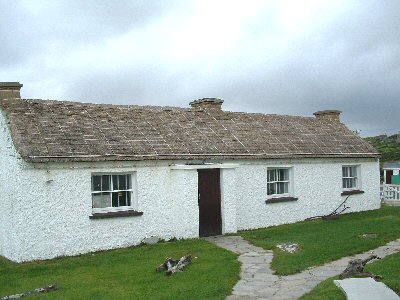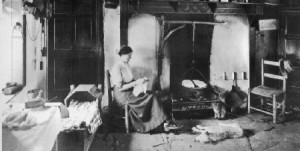Folklore
Pulling the Flax Plant
‘There wasn’t a lot of flax-growing in Fathom those days.
It’s a very stalky plant, dark green at first, turning light green. It produces a lovely blue flower. It was the phloem – inside – of the plant that was valuable as linen thread. Harvesters pulled it physically out of the ground. It was gathered in bunches -beets, they were called – sheaves about two feet in diameter. There were twelve beets to a stook, the twelfth laid crosswise over the others, to determine the dozen. It was a hard pull, especially from clay soil that hardened in the summer time.
The Fifth of December
Fear of the Banshee still runs deep in the Irish country psyche.
Street Rhymes
Skipping, hop-scotch and juggling up to three balls against a wall were the exclusive pursuits of young girls in my day. All were accompanied by rhymes either short or long. I was envious that this ‘poetry’ was not for us boys, and gob-smacked that every girl knew them all by heart. I would be delighted if any older ‘girl’ who remembers those I do not, would contact the Journal with their words! Below are just a few that I do recall.
When I was young I had no sense
I bought a fiddle for eighteen pence
But the only tune that I could play
Was ‘Over the hills and far away’.
Healing Heather Wine
Irish Lucky Charms – Why and How
There are many lucky charms and symbols that are related to the Irish and are considered lucky. Many of these Irish lucky charms have historical significance, and many are simply based on myth, legend, or folk tales. Here’s a good way to get an idea of the mythical and cultural history of the Irish and their luck (and also have a good laugh): If you have never seen the movie ‘Darby O Gill and The Little People’ – you need to sit down and watch it to get sucked in to the magic and tales of Irish folklore and fairies.. and of course the luckiest battle of wit you will ever see!
Any true believer in Irish Folklore will inform you that catching a leprechaun fairy (leprechauns are members of the Fairy Folk) will bring good luck. If you can hold on to him tight enough, and technically hold him hostage for long enough, the leprechaun will grant you three wishes in exchange for his freedom. The mischievous little green man is also well known to hide his pot of gold at the end of rainbows, so if you’re lucky enough to get to the end of the rainbow, finders keepers.. eh?.
History of Irish Good Luck Charms
According to the book “The Element Encyclopedia of Magical Creatures,” by John and Caitlin Matthews, the legend of the leprachaun can be traced back to eighth-century tales of water spirits called “luchorpán,” meaning small body, according to John and Caitlin Matthews book the legend eventually evolved into a mischievous household fairy said to appear in cellars, play tricks on people, and drink heavily. Like any good Irish man or woman, right? Although a mascot of Ireland and supposed bringer of luck in the form of gold and wishes, the leprechaun is not the only symbol or charm in Irish tradition.
Four Leafed clover
Four-leaf clovers are a rare find, and were used as magical charms by Celtic priests who believed the little gem would protect them against evil spirits. The Celts believed that four-leaf clovers would allow them to be able to see mischievous fairies, and dodge their shenanigans, which were viewed as unlucky. And you would understand why if you had experienced the little menaces as many an Irish man has – just ask Darby O’Gill! They are to this day still believed to have magical powers including luck, hope, love, and faith. Four-leaf clovers are incredibly rare, which is one of the things that leads to them being seen as so lucky.
A Lucky Penny
As long as you have a penny in your pocket you are never broke! The idea of a lucky penny is “a small sum given back ‘for luck’ to the purchaser or payer by the person who receives money in a bargain or other transaction,”. In It is still a tradition to some Irish people to give a luck penny in some instances like buying a new home, or your granny will always pop a lucky penny in the new purse she buys you for Christmas. Not so nice when she puts one in the mix of her yummy fudge and forgets to tell you! Giving a Luck Penny originates back to an old Irish tradition originally associated with the buying and selling of farm animals. After buyer and seller agree their deal, it is sealed by each spitting into the palm of their hands, and closed with a lovely firm handshake.
Now, the seller must immediately give back the buyer a gift of a sum of money for “Good Luck”. This is an important ritual because failure to give back a Luck Penny could bring ill fortune to them both. Traditionally, (and you couldn’t break tradition now, could you?) both buyer and seller then head to the local pub where the “Lucky Penny” is used to buy the first round of celebratory drinks for them both.
In the days when a penny had a lot more value, the “Luck Penny” was just that, a penny. These days the “Luck Penny” gift is more of a token than of any real monetary value. Nevertheless, the tradition of referring to this gift of cash as a “Luck Penny” remains.
Horseshoe
Horseshoe charms are one of the hugely popular good luck charms popular throughout Ireland. Again, there’s a fairy link here – horseshoes were made of iron, which fairies cannot stand, so it was important for warding off their mischief. There’s another legend about Saint Dunstan, a blacksmith who was ordered by the devil to shoe his horse. Instead, he nailed the shoe to the devil’s foot only removing it after the devil promised to stay away from any home with a horseshoe. Hence, displaying a horseshoe in the house is considered to be lucky for warding off evil.
Luck of the Irish
‘Irish luck’ might seem like a strangely pervasive term in light of a nation that has experienced a devastating potato famine, generations of English oppression, and a history of relentless rain. Nonetheless, Ireland is imagined by many as a nation brimming with lucky gold coins and shamrock charms.
The phrase, ‘luck of the Irish’ is commonly thought to mean “extreme good fortune.” However, according to Edward T. O’Donnell, an Associate Professor of History at Holy Cross College and author of “1001 Things Everyone Should Know About Irish American History”, the term has not an Irish origin but in fact an American one.
During the gold and silver rush ears in the 19th century, some of the Irish miners (or of Irish American descent) made great fortunes. Over time this association of the Irish with mining fortunes led to the development of the expression ‘luck of the Irish’. Of course, it carried with it a certain tone of sarcasm, with an undertone of the idea that, only by sheer luck, and not brain power, could these eejits succeed.
Many suggest the phrase stuck around in part because of the note of irony attached to it, considering how actually, the Irish have actually been pretty unlucky throughout history – from the ruthless pillaging of the Vikings, to families pulled apart by emigration, death and famine, and today’s prevailing discrimination against redheads. But despite this, and partially fueled by the fact that thee Irish have suffered their fair share of ill fate, they have developed a dark sense of humour.
Needless to say, Ireland’s folklore is embellished with luck, even if its factual history is not. Ireland is a luscious and welcoming country full of cosy pubs, friendly faces, beautifully haunting music and gorgeous moors of emerald green.
With an incredible heritage of which to be proud, and a global significance of which to be proud – it seems that the Irish are a little lucky after all. And that is most definitely worth a toast and a singsong over a pint of Guinness on St Patrick’s Day!
So in the words of the Fairy King according to Darby O Gill himself;
‘Tis more than your wish was. Nayther you nor anyone who sits at your table, through all your life, will ever want a bite to ate or a sup to drink, nor yet a silver shilling to cheer him on his way. Good luck to all here and goodbye!”
Famous Irish actress Valene Kane The Fall is well known for her love of lucky charms as well!
Leprechaun Good Luck Charm
Some Irish people still see the leprechaun as a good luck charm. Leprechauns are not real, but they do come from popular Irish folklore. These small people were the shoemakers who took what they made from making shoes and put them in a pot at the end of a rainbow.
People often times look for leprechauns to try and get them to give away a piece of gold, but also because leprechauns are supposed to be good luck!
Second Marriage
‘A woman died an’ left her husband sorrowing with a baby boy. He’s grief wus tarrable, but quick an’ sudden over like, as such griefs sometimes are. An’ before he’s wife wus more than coul’ in the oul’ burial groun’ of Creggan, he’s fancy wus captured by another. An’ in a short time he wus again before the altar.
May Day Pistogues
If you happen to see a strip of hawthorn bush draped with May flowers and eggshells before a cottage door, you will know that this simple custom is a pardonable – and permissable – factor in the queer rites and customs that once characterized the first day of May, in olden times.
You may have heard the word ‘pistogues’. If you haven’t, I’ll tell you what they are/were. Pistogues are little acknowledgements of the existence of the supernatural and the embodiment of witchcraft that often accompanied it here: a kind of appeasement of the gods that ruled the destinies of earlier inhabitants, who themselves were past masters in the art of witchery and spell-casting – even hypnotism. Only last Saturday, outside the Craft Fair at An Cuan in Rostrevor, my friend Leontia Keogh befriended a practitioner who wanted to exercise his art. And exorcise some alleged demons. With what results, I have yet to learn!
If you want to see some such pistogues, pay a visit to St Bridget’s Well in the graveyard at Faughart!
It tempers one’s scepticism somewhat to reflect that maybe those old rite of May Day were the remnants of the art of the ancient peoples – transmuted somewhat by the ravages of centuries. May Day was a day when ordinary mortals could empower themselves with these forces of the supernatural to cast spells – and the like – on their neighbours. I was in conversation with an old fella of my acquaintace on the subject.
‘”Ye know, ye daren’t put the May Bush up on May Day itself,” he whispered, his sunken eyes leaving spirals of wrinkles on the eye sockets now gawping through dust and the exhaust fumes of a passing car. He peered as though into the dim centuries of mysticism, as a pronounced quietitude and peace gathered shadow over the bog.
“Why can’t I, if I like?” I asked, foolishly. I cannot interpret his withering stare.
“Sure man, you’d have the divil’s own luck if you done that! Man, sure , they used to say it wasn’t right to plack a May flower afore May Day.
Och, aye, t’was all right te pluck them to put on the May Bush. THAT was no harm at all. Not a bit.
More ….
Noble Ploughman: .. end …
Since man first turned the soil with his crude spade, revolutionary changes have merged into a progress which has created new worlds above the soil. But it is still the same soil, and generally speaking producing the same foodstuffs for generally the same purpose.
As each scrape rises, turns and is folded over by the board, the furrow is fresh with dark-brown soil, from which rises a not unpleasant but queerly sour scent of earth. One is gradually minded of some great rtevelation being unfolded: as if the invisible veil of Time itself were being drawn off the great facts, the sacrifices and the stories now in the cold print of the history books. One even feels the close, natural kinship which exists between man and earth – of which only those in constant communion with the earth are aware.
The land was dug with spades before the plough was invented. When I see fields that, within living memory, were spade-dug by man, I marvel at such herculean tasks. Ploughs then were few and far between.
There are a few wooden ploughs still retained for sentimental reasons or as museum pieces. The spade was not been done away with. It is still used for gardens and allotments and for digging round stones which the plough must pass over. I have seen ploughmen with fast teams thrown clear of the handles after hitting such a stone. Though most of the great ones are well-known. Their location is passed down from generation to generation – as is the location of underground shores or drains.
” …. an’ about two perches out from the big bush in Paddy’s Hill field there’s a bad stone! Now, watch yourself there! I remember being thrown … “
It is such hidden stones that make the blacksmith’s forge “thronged ground” during the ploughing season, for almost everyone who enters has a sock to be mended or ‘squared’ or pointed with steel. The ‘sock’ by the way is a detachable part of the plough which fits onto the sole-plate and which cuts the scrape underneath. The ‘coulter’ – an iron knife on the forward beam, slices the sod.
In the forge the men talk of the incidents which occurred during their labours that day; about teams, ploughs and horses; and then go to their homes with the mended socks in readiness for renewed work the next day.
It seems a humble calling: but all great labours are remote and inconspicuous. For the song of the plough sings gently of the most distinguished labour in the civilized world. Men labour that men may live when clay-clogged footsteps walk in fresh brown furrows after a team of pulling horses.
… end …

